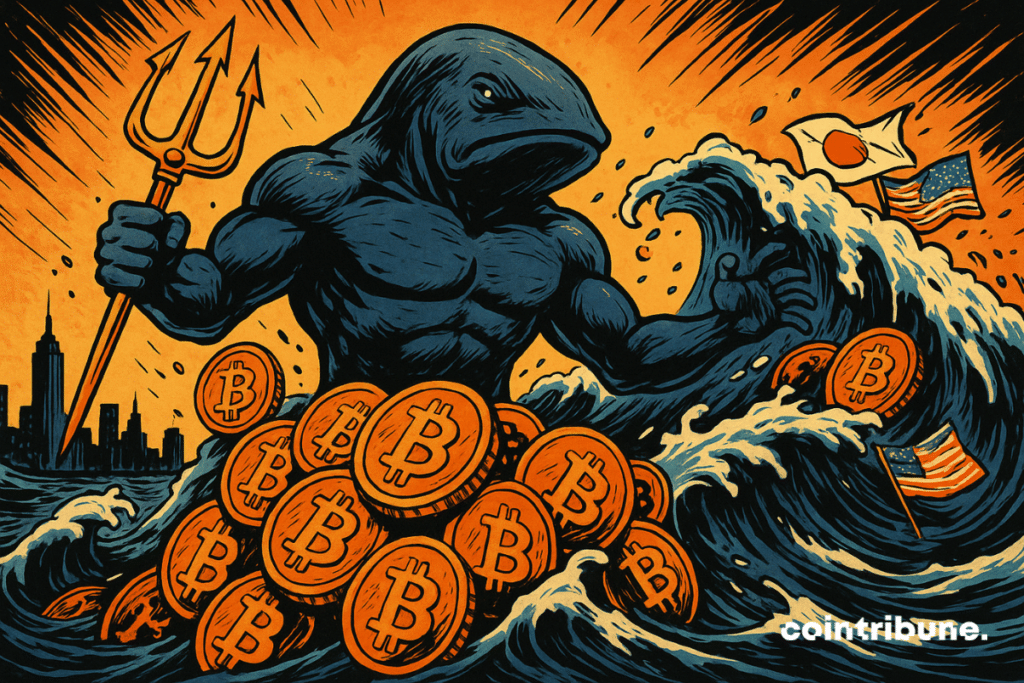Why Bitcoin Demand Remains Strong Despite Market Panic
It is not uncommon to see large wallets hail bitcoin when it reaches the highs. But it is in calm, sometimes even in the storm, that they court it the most. This end of consolidation at $114,000 did not slow their appetite. In the crypto-sphere, some habits do not change: the more the market doubts, the stronger the convictions become. Whales do not flee volatility. They embrace it.

In Brief
- Bitcoin stays above $110,000 despite volatility and market pullback.
- In 30 days, 160,000 BTC were accumulated according to the apparent demand indicator.
- Whales have strengthened their wallets with 50,000 BTC with no recorded sale.
- OTC supply dropped to 145,000 BTC, reinforcing scarcity and long-term strategy.
Lows, but no abandonment: bitcoin accumulation continues
The recent drop of the bitcoin price to $111,971 may have worried the most exposed investors. Yet, demand indicators tell a different story. This is highlighted by analyst Darkfost on X. According to him, the “apparent demand“, which measures the difference between the issuance of new BTC and tokens inactive for over a year, remains in positive territory.
He specifies: “Currently, demand remains clearly positive, with around 160 000 BTC accumulated over the past 30 days“. This trend confirms that the market absorbs more bitcoins than it creates, even in a hesitant price phase.
At the same time, bitcoin remains technically solid. The 110k threshold forms a base many watch. And sales volumes, although declining, do not signal panic. BTC resists, and confidence has not evaporated in the crypto industry.
Crypto whales reload while the market doubts
The whales, those large addresses that buy without ever selling, have strengthened their presence. The indicator “accumulator addresses”, monitored by Darkfost, shows a net increase of 50,000 BTC bought in the last 30 days. It’s not a fad; it’s a conviction strategy.
These signals add to the data from OTC Desks. Three years ago, these off-chain counters held 550,000 BTC. Today, they hold only 145,000 BTC. In other words, institutions are taking bitcoin out of visible circuits. They are preparing, in the shadows, for a scenario where supply drastically tightens.
In a crypto industry where the instantaneous reigns, this kind of contrarian vision says a lot about the market’s real state.
Between volatility and strategy: the numbers speak
The BTC price hesitates under $115,724, stuck between resistance and expectation. But the fundamental data is reassuring. The 50-day moving average remains above $100,000, and the 110k level has not broken. The market is not collapsing: it is repositioning.
What the key numbers show:
- 160,000 BTC were accumulated in one month, despite price declines;
- Whales added 50,000 BTC to their wallets without selling a single satoshi;
- OTC desk supply dropped from 550k to 145k BTC since 2021;
- BTC trades between $111,000 and $115,000 without signs of massive selling;
- Declining sales volumes suggest a market more observant than panicked.
These data draw a baseline: bitcoin remains, for a large part of the crypto industry, an accumulated and anticipated asset, even when the spotlight dims a bit.
As the weeks pass, some experts believe bitcoin could bounce back much stronger than expected. In specialized circles, a symbolic threshold begins to circulate: $148,000. Far from a prophecy, this hypothesis relies on cyclical analysis. In the crypto universe, each shock often prepares the next rise.
Maximize your Cointribune experience with our "Read to Earn" program! For every article you read, earn points and access exclusive rewards. Sign up now and start earning benefits.
La révolution blockchain et crypto est en marche ! Et le jour où les impacts se feront ressentir sur l’économie la plus vulnérable de ce Monde, contre toute espérance, je dirai que j’y étais pour quelque chose
The views, thoughts, and opinions expressed in this article belong solely to the author, and should not be taken as investment advice. Do your own research before taking any investment decisions.